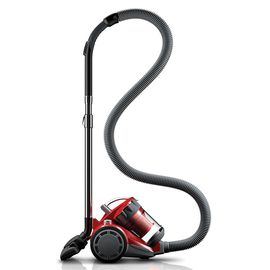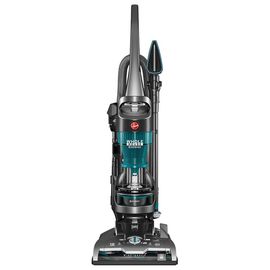Best Vacuum Cleaners
Vacuum cleaners are one of those ho-hum appliances found in almost every home. An effective and reliable vacuum is essential for suctioning up the dirt, dust, and debris that settle onto floors and upholstery on a never-ending basis. There are plenty of types to choose among -- upright, canister, stick, handheld, even robotic. We cover the latter two styles in separate guides, but we picked through the rest of the offerings, both bagged and bagless, and read scores of reviews to glean the best vacuum cleaners under $150.
Our Top Pick


Bissell CleanView With OnePass 9595A Review
Best Upright Vacuum Under $100
Pros:
- 12-amp motor delivers strong suction that conquers pet hair, experts and users say, with particularly impressive performance on bare floors.
- 5 height settings; brushes and suction on the sides for cleaning along baseboards.
- 6-foot hose, TurboBrush, crevice tool, dusting brush, and extension wand.
- HEPA and washable foam filters.
- 25-foot cord.
- 2.2-liter dust cup.
Cons:
- Less effective at pulling up embedded dirt from carpets in expert testing.
- No suction control.
- Scattered complaints about excessive noise, dust leaking out of the exhaust, or a chintzy build.
Takeaway: Tried and true, this Bissell upright vacuum exceeds thousands of users' expectations, according to reviews. It deftly handles jobs often left for heavier-duty machines, like picking up pet hair. Its strong suit seems to be hardwood and other bare surfaces, but this vacuum acquits itself nicely on carpets and rugs, as well. Users appreciate the five height settings, long 25-foot cord, large dirt cup, accessories, and value price.

Bissell Zing 2156A Review
Best Canister Vacuum Under $100
Pros:
- Very strong suction works equally well on bare floors, rugs, and upholstery, according to reviews.
- Variable suction control; bare floor and carpet settings; automatic height adjustment.
- Combination crevice tool/dusting brush and extension wand.
- 2-liter dirt cup.
- 3-stage filtration.
- Automatic cord rewind.
- Lightweight, at 10.23 pounds.
- "Best Bang for the Buck" among canister vacuums in BestReviews' comparison.
Cons:
- Accessories don't always stay attached, users report, and there's no onboard storage.
- Debris may collect near the top of the dust cup, requiring frequent dumping.
- Scattered griping about weak suction from the 9-amp motor.
- 16-foot cord and 4-foot-8-inch hose are relatively short.
Takeaway: The full-featured Bissell Zing bagless canister vacuum surprises many reviewers with its all-around usefulness. Many report having bought this lightweight model for light duty in the car and quick touch-ups on floors but set it to work on more challenging tasks, with good results. At a little over 10 pounds and fitted with a carrying handle, the vacuum is easy to cart around.

Dirt Devil Featherlite Cyclonic SD40120 Review
Good Cheap Bagless Canister Vacuum
Pros:
- Compact but does the job adequately, many reviewers say, especially on bare floors, small area rugs, and car interiors.
- Variable suction control.
- Swivel steering.
- Crevice/brush tool and telescoping wand.
- Automatic cord rewind.
- Lightweight, at 10.2 pounds.
- Rinsable HEPA filter.
Cons:
- No rotating brush roll for carpet cleaning.
- Some grousing in reviews about insufficient suction from the 8-amp motor.
- Some complaints about the vacuum tipping over when pulled.
- Tiny 0.6-liter dirt cup.
- Relatively short 16-foot cord.
Takeaway: For the most part, users like the inexpensive Dirt Devil Featherlite Cyclonic. It's easy to maneuver and carry around, and a 5-foot hose, telescopic wand, and dusting/crevice tool extend its reach into high and tight spaces. Seniors and users with small homes are well pleased with this model, noting user-friendly qualities such as the compact size, bagless design, rinsable filter, and good pickup.

Eureka Mighty Mite 3670G Review
Good Cheap Bagged Canister Vacuum
Pros:
- Easily cleans bare floors and outdoor spaces, according to most user reviews.
- Blower port makes it ideal for decks, patios, and garages.
- Crevice tool and dusting brush; onboard tool storage.
- Lightweight, at less than 9 pounds.
Cons:
- Some complaints about poor build quality and crimping in the hose.
- Scattered gripes about loud noise.
- Disappointing power from the 12-amp motor, some users say.
Takeaway: Marketed as the canister vac for bare floors, whether indoors or out, this model might be of limited use to people with lots of carpeting in their homes. Some reviewers caution that the floor nozzle just can't handle the pile on a rug, but most users are quite pleased with the oomph of the Eureka 3670G Mighty Mite canister vacuum. They say it's user-friendly and more than adequate for many cleaning tasks. Many also appreciate that it uses bags to keep dirt contained and avoids the potentially messy task of emptying a dust cup.

Hoover WindTunnel 2 Whole House Rewind UH71250 Review
Good Cheap Upright Vacuum
Pros:
- Pulls up pet hair, light debris, and hidden dirt from carpets with ease, according to reviews.
- 12 amps and 2 channels of suction.
- Allergen-blocking technology with a rinsable HEPA filter and odor-absorbing carbon filter.
- Multi-floor brush roll with an on/off pedal.
- 5-setting height adjustment.
- Stretch hose, pet turbo tool, pivoting dusting brush, and crevice tool; onboard tool storage.
- 25-foot cord with auto rewind.
- 3-year warranty.
Cons:
- Disappointment with the upholstery tool among some reviewers.
- Some complaints about overheating.
- Some desire for a longer cord or a larger dirt cup (1.29-liter capacity).
- Heavier than other top picks, at 16.1 pounds.
Takeaway: Users laud the features on this Hoover WindTunnel vacuum, particularly the retractable cord, height adjustment, easy-to-change attachments, and easy-to-empty canister. They likewise commend the results, with several noting that carpets look much cleaner -- new, even -- after a once-over. This versatile vacuum provides a good balance between performance and price.

Hoover WindTunnel 3 Pro Pet UH70930 Review
Pros:
- 12 amps and 3 channels of suction do the trick for pet hair and general debris, some users say.
- Washable HEPA filter.
- 5-position height adjustment; multi-floor brush roll with on/off switch.
- Pet turbo tool, crevice tool, pet upholstery tool, and telescoping extension wand.
- Long 10-foot hose and 27-foot cord with auto rewind.
- 1.36-liter dirt cup is a snap to empty, users say.
Cons:
- Lots of complaints about performance and durability.
- On the heavy side, at about 17 pounds.
- Average rating of 2.5 out of 5 stars from more than 250 reviewers on Target.com.
- Average of just 3.1 stars from more than 650 reviewers on Hoover.com.
Takeaway: The Hoover WindTunnel 3 Pro Pet Upright (model UH70930) comes loaded with pet-specific tools, but that's not enough to allay users' disappointment. Reviews harp on poor reliability, citing mishaps such as overheating, clogging, turbo tools that quit agitating, and generally weak performance. Other vacuums -- including specialized models aimed at pet owners -- cost less and give users less to lament.

Dirt Devil Jaguar UD70230 Review
Pros:
- Suctions up pet hair as promised, some reviewers say.
- Rinsable HEPA filter with carbon odor management.
- 5-level height adjustment.
- Long 25-foot cord and 8-foot hose.
Cons:
- Complaints from users about weak performance and components.
- Many reviews call the longevity into question, and the 1-year warranty is relatively short.
- Of the nearly 130 customers who have reviewed this model on the manufacturer's website, two-thirds give it a negative rating (1 or 2 stars).
- Lackluster average of 3.3 out of 5 stars from nearly 160 reviewers on Amazon.
Takeaway: Problems abound with the Dirt Devil Jaguar UD70230 Pet Upright Vacuum, according to a majority of reviews. Users bemoan a hose that doesn't stay connected, turbo pet tools that don't rotate, filters that clog, and a motor that cuts out. Some of the critical reports were even posted by users who received this vacuum as part of a promotion. It includes pet-specific, electrostatic attachments with agitating motion, and boasts a very frugal price, but the weight of negative reviews suggest bypassing this model.




















